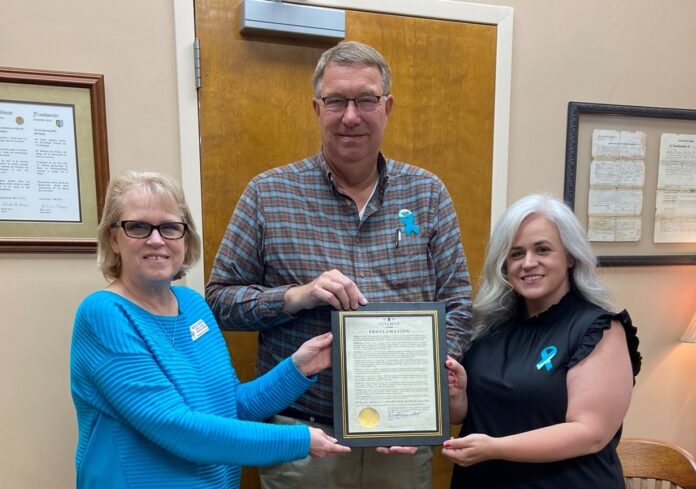CULLMAN, Ala. – April 2023 marks the 22nd anniversary of Sexual Assault Awareness Month (SAAM). On Monday, April 3, 2023, Mayor Woody Jacobs officially proclaimed the month of April 2023 Sexual Assault Awareness Month in the city of Cullman. On hand to accept the proclamation from Victim Services of Cullman (VSOC) were Client Intake Advocate Lacey Lemley and Domestic Violence Facilitator Susan Jones.
“We are happy to support Victim Services in increasing awareness of this issue that affects many in our community,” said Jacobs.
About SAAM
SAAM was first nationally observed in 2001. But even before that, advocates held events and observances to bring awareness to the issue of sexual violence.
In the beginning, the primary goal of SAAM was awareness. But gradually, SAAM began focusing on ways that individuals and communities can stop sexual violence before it happens by changing behaviors and promoting respect. Today, SAAM is about both raising visibility about sexual violence and sharing ways that it can be prevented.
The symbol for SAAM is the teal ribbon. Individuals and communities in Cullman and across the country are encouraged to show their support for survivors of sexual violence by wearing denim on April 26 and posting a selfie on social media with #denimday2023.
VSOC personnel will be placing teal ribbons throughout the city. They will also be posting information on other events and observances taking place throughout the month at www.facebook.com/victimservicescullman.
This year’s SAAM campaign theme is “Drawing Connections: Prevention Demands Equity.” This campaign calls on all individuals, communities, organizations and institutions to endeavor to build a foundation of racial equity and respect. The National Sexual Violence Resource Center (NSVRC) calls on everyone to “take ownership of this moment to build up their own understanding of the ways in which systems of oppression such as racism, sexism, classism, heterosexism, ageism, ableism and others contribute to higher rates of all types of sexual violence.”
About sexual violence
Sexual violence can have long-lasting psychological, emotional and physical effects on survivors. The Rape, Abuse and Incest National Network (RAINN) defines sexual violence as any type of sexual contact or behavior that occurs without explicit consent of the victim. Consent is an agreement between participants to engage in sexual activity, and it should happen every time.
Some perpetrators use emotional coercion, psychological force, manipulation or intimidation to coerce a victim into non-consensual sex. Some will use threats, such as threatening to hurt the victim or their family. And some will use physical force. Examples of sexual violence include attempted or completed rape, unwanted sexual touching, child sexual abuse, incest, drug-facilitated sexual assault, stalking, sexual abuse of people with disabilities, sexual harassment and more.
Preventing sexual violence
Risk factors: According to the Centers for Disease Control (CDC), there is a combination of individual, relational, community and societal factors that can contribute to the risk of becoming a perpetrator of sexual violence. Individual risk factors include (but are not limited to) alcohol and drug use, aggressive behaviors, and acceptance of violent behaviors, lack of concern for others, exposure to sexual-explicit media, hostility toward women, a family history of conflict and violence, a childhood history of abuse, poor parent-child relationships, association with sexually-aggressive peers and prior sexual victimization or perpetration. Community and societal risk factors include a general tolerance of sexual violence within the community, societal norms that support sexual violence, weak laws and policies related to sexual violence and high levels of crime and other forms of violence.
Protective factors: Protective factors can exist at individual, relational, community and societal levels and may lessen the likelihood of sexual violence. These protective factors include families who work through conflicts peacefully, emotional health and connectedness, academic achievement and empathy and concern for how one’s actions affect others.
Engaged bystanders: There are actions bystanders can take to help prevent sexual violence. While it may not be safe or effective to directly confront someone directly, bystanders can be involved before, during, or after a situation when they see or hear behaviors that promote sexual violence. Some strategies and tips from NSVRC include:
- Disrupting the situation. When someone is being harassed, threatened, or followed by someone, a bystander can try to distract the harasser (by asking for directions, for instance) or can insert him/herself into the interaction to help the targeted person get out of the situation (by pretending to know the person being harassed and starting a conversation with them, for example).
- Getting support from other people by calling on others to help. If it’s not safe to confront the harasser, a bystander can contact police and report the harassing actions.
- Confronting the harasser. Telling the harasser in a respectful, direct and honest way that their words or actions are not okay.
- Ensuring the target of the harassing words or actions knows that it’s not their fault.
- Taking action online. Responding to online comments that blame victims of sexual violence or that contribute to an online culture in which sexual violence is tolerated and not taken seriously. Responding to victim-blaming, rape jokes or other like comments online. Linking to educational resources about sexual violence prevention.
Reporting sexual violence
VSOC has a 24-hour crisis line serving residents of Cullman, Marshall and Winston counties. That number is 256-734-6100.
RAINN organizes the National Sexual Assault Telephone Hotline, a referral service that puts callers in contact with local rape crisis centers. That number is 1-800-656-4673. It also has an online chat service at www.rainn.org/get-help.
National sexual assault statistics
According to the CDC’s latest National Intimate Partner and Sexual Violence Survey (NISVS) – an ongoing nationally representative survey that assesses sexual violence, stalking, and intimate partner violence victimization among adult women and men – one in five women and nearly a quarter of men in the U.S. experience completed or attempted rape or some form of contact sexual violence in their lifetime. Statistics compiled by the NSVRC also show that:
- Approximately 1 in 3 female victims and approximately 1 in 4 male victims in the U.S. first experienced completed or attempted rape or other sexual assault between the ages of 11 and 17.
- About half (51.1%) of female victims and over half (52.4%) or male victims in the U.S. reported being raped or sexually assaulted by an intimate partner; 40.8% by an acquaintance.
- RAINN statistics show that approximately 8 out of 10 sexual assaults are committed by someone known to the victim.
- RAINN reports that there are approximately 321,500 people aged 12 and older who are victims of rape and sexual assault yearly. They also state that the actual total may be higher since it is believed that most sexual assaults are not reported to law enforcement.
- More than 1 in 4 non-Hispanic Black women (29%), more than 4 in 5 American Indian and Alaska Native women (84.3%), 1 in 3 Hispanic women (34.8%), 32.9% of adults with intellectual disabilities and 47% of transgender people in the U.S. have experienced some form of sexual violence in their lifetimes.
About VSOC
VSOC was established in 1991 for victims of domestic violence. In 1996, VSOC began providing services to victims of sexual violence. VSOC provides crisis response, recovery, and prevention programs for families impacted by domestic and sexual violence. Some of the services VSOC offers victims of sexual violence include free and confidential crisis counseling, information and referrals to other services and Sexual Assault Nurse Examiner. VSOC also provides community outreach and education programs in an effort to reduce the risk of sexual violence.
Sexual violence prevention and recovery resources
For more information on sexual violence, contact:
- Victim Services of Cullman (VSOC) www.victimservices.online Phone: 256-775-2600
- Alabama Department of Public Health: www.alabamapublichealth.gov/injuryprevention/sexual-assault-and-rape.html Toll-Free: 1-800-CDC-INFO (232-4636) TTY: 1-888-232-6348
- National Sexual Violence Resource Center (NSVRC) www.nsvrc.org TTY: 717-909-0715 Toll-Free: 877-739-3895 Email: resources@nsvrc.org
- Rape, Abuse & Incest National Network (RAINN) www.rainn.org Toll-Free: 1-800-656-HOPE(4673)
- Alabama Coalition Against Rape (ACAR) www.alabamacoalitionagainstrape.org
- Phone: 334-264-0123 Toll-Free: 1-800-656-HOPE(4673) Email: ACARinfo2022@gmail.com
If you are a victim of sexual violence:
- Confide in a trusted friend or family member
- Contact local law enforcement
- Call VSOC’s 24-Hour Crisis Line at 256-734-6100
Call the National Sexual Assault Hotline at 1-800-656-4673 or by chat at www.rain.org/get-help


























